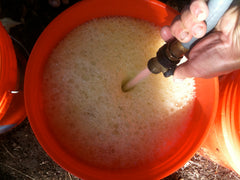Fully ripe disease-free tomatoes are the best candidates for seed saving. Seeds can be saved casually by squeezing them out in a paper napkin and air drying them but fermentation is a better route. Fermentation removes germination inhibitors and the gelatinous sheath from seeds, and it may treat some seed-borne diseases. Properly stored tomato seeds may remain viable for over six years.
Step-by-Step Tomato Seed Saving
1. Rinse tomatoes in water to remove dirt before harvesting seeds. Cut off open or damaged parts of fruit. We collect tomatoes in 5 gallon buckets then fill them with water. Cleaning any dirt off becomes a natural sweeping motion with your hands as you grab tomatoes from the water.
2. Cut open ripe tomatoes one variety at a time and squeeze the pulp, juice and seeds into a container. If you have strong hands, you may crush the tomato in a five gallon bucket. Try to develop skill holding the tomato right side up and of opening the tomato from the bottom blossom and with your fingers, then milking the germplasm gel which contains the seeds off the central column. This is the fastest method.
3. Pour into an container with a lid. Do not add water as a substitute for tomato juice since dilution slows fermentation.
4. Label and set aside the containers for 3 days at a temperature not more than 70 degrees.
5. Stir the fermenting juices to submerge the pulpy material, once or twice daily. The prevents the build up of mold which is not harmful to the seeds but may discolor them.
 6. After three days decant. Pour into a larger container that allows you to add three or more times the volume of water and pour off the pulpy water but not the seeds at the bottom. Viable tomato seeds will sink. Repeat two or three times until seeds are clean. Note not all viable seed varieties sink in water.
6. After three days decant. Pour into a larger container that allows you to add three or more times the volume of water and pour off the pulpy water but not the seeds at the bottom. Viable tomato seeds will sink. Repeat two or three times until seeds are clean. Note not all viable seed varieties sink in water.
7. If selling seeds commercially, soak clean seed in water with a cap of antibacterial bleach, 10% bleach solution, for 30 minutes to kill seed borne disease. Then rinse seed under cold running water for 7 minutes constantly agitating and stirring the seed. This post-soak rinsing is needed to reduce total residual chlorine to below the National Organic Program (NOP) standard of four parts per million. Sanitize equipment thoroughly between uses to eliminate Late Blight contamination.

9. Tap the strainer or rub your hand under it to remove excess water. Flip the strainer over, smacking it on a paper plate to deposit the seeds or allow seeds to dry on a screen.
10. Label drying plate or screen with the variety name and date harvested.
11. Let the seeds dry for 5 to 6 days at room temperature in a well-ventilated place. Stir and crumble seeds with your fingers daily to prevent them clumping together. As the seeds dry, lightly rub clumps together between your palms to separate seeds. We also rub dry seeds through a #2 cleaning screen .132 to separate remaining clumps before bagging, available from www.horizonherbs.com.
12. Store in zip lock plastic bag in a cool, dark, dry place. Place label inside the bag. Refrigeration of seeds is not necessary but okay. Do not freeze seeds.
---
Here is a bucket of pulp from freshly crushed tomatoes waiting to be poured into a smaller container to ferment for three days. Below is Bridget standing in front of some of the drying racks at Restoration Seeds.

---
© 2013–2018 Restoration Seeds, LLC

